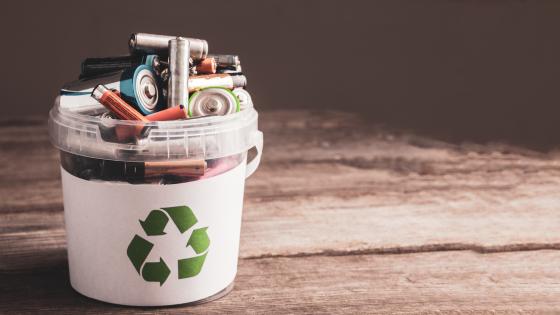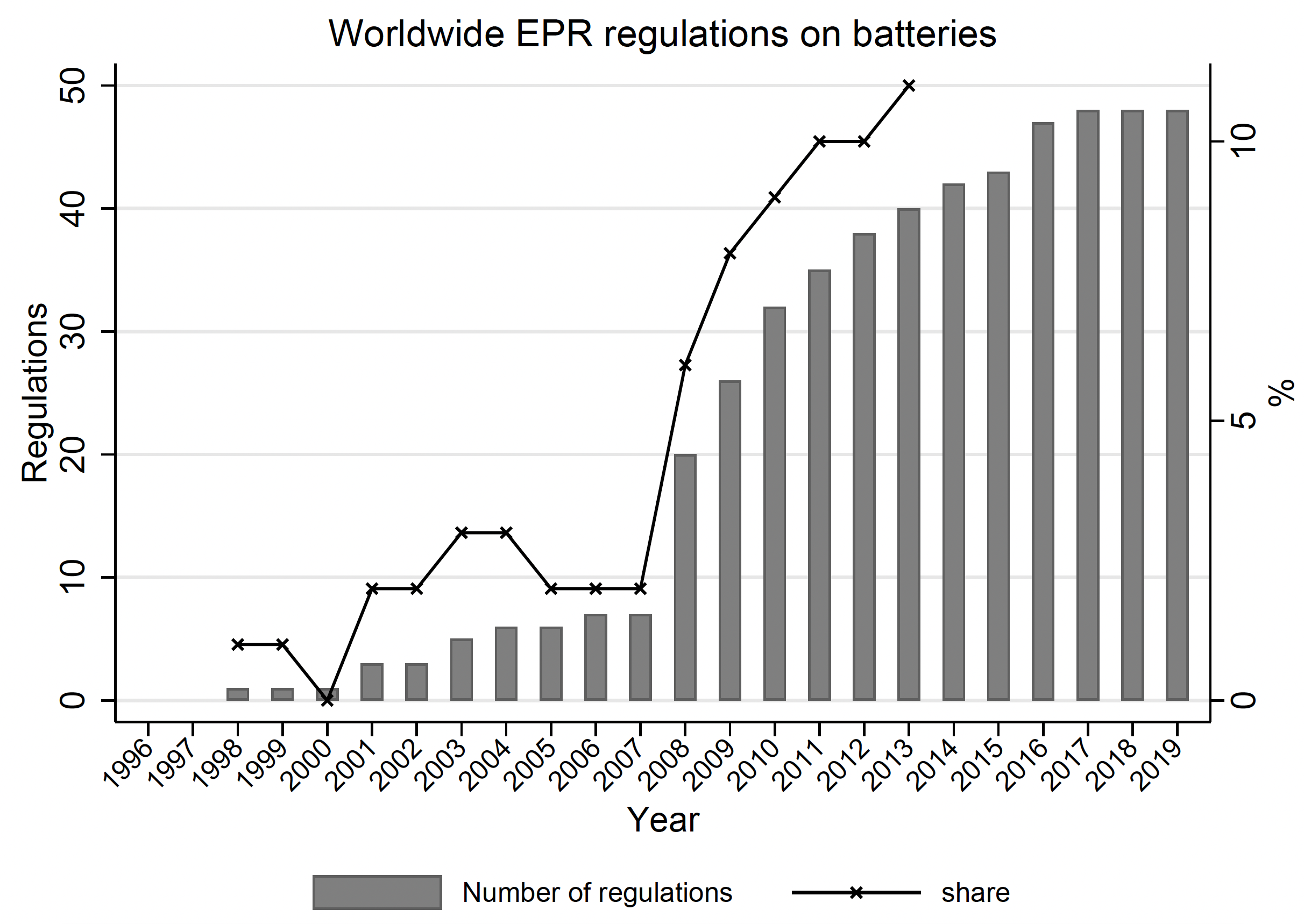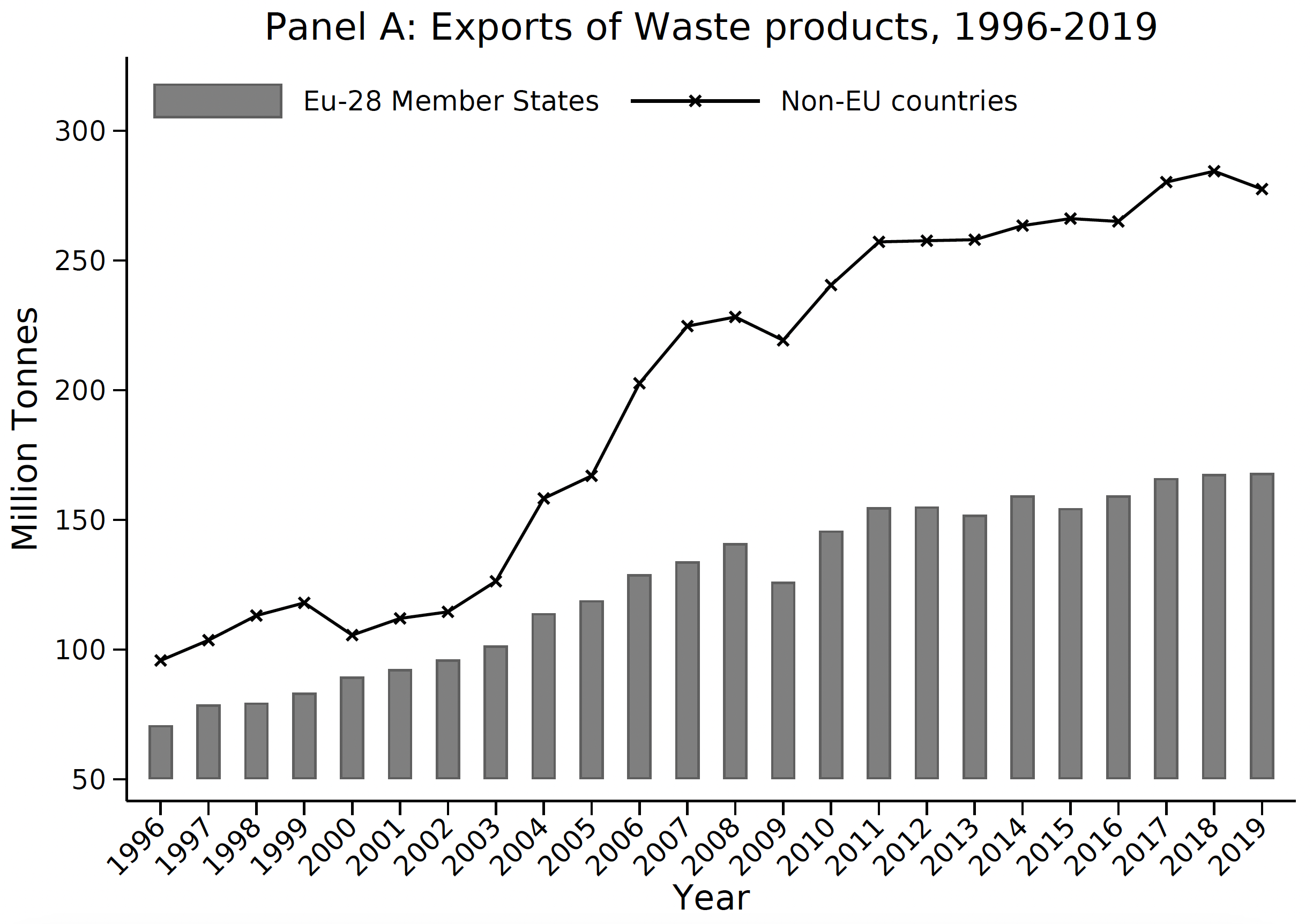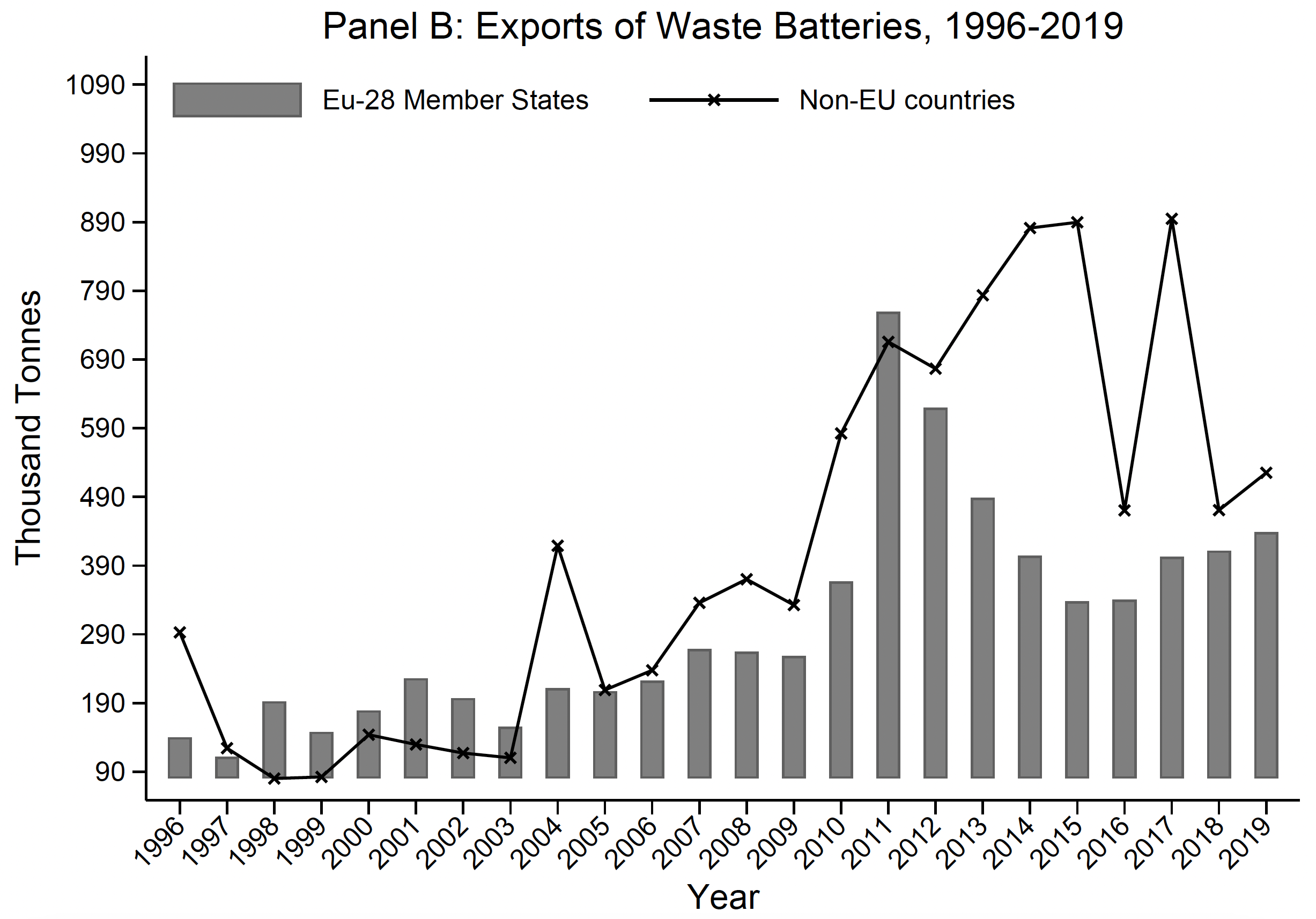The literature on international trade in waste typically considers this commodity as a source of pollution, that is, a negative environmental externality (Levinson and Kellenberg 2014). This is consistent with regulations such as the Basel Convention and the EU Waste Shipment Regulation (2006), which aim to restrict waste export flows, especially from developed to developing countries, where waste management infrastructures are often inadequate.
In parallel, strategies to strengthen circular economy systems have received growing attention in recent years. The environmental and economic benefits are manifold: they ensure sound environmental management of waste flows; recover materials that can be substituted for virgin ones, thus alleviating the pressure on resource extraction and lowering the overall environmental impact of value chains; and reduce supply risks and price volatility of raw materials. International circular economy networks offer further advantages, such as the development of economies of scale for waste treatment, waste management technologies, and an outlet for recycled materials (Egger and Keuschnigg 2023, Kojima 2020).
Nevertheless, this resource-oriented perspective on waste trade remains a minority in the economics literature. A better understanding of the potential interactions between international trade and waste policies is needed to ensure an effective global transition to a circular economy (Yamaguchi 2018).
In a recent paper (Compagnoni et al. 2023), we investigate the impact on the waste trade of one of the main policies to support circular economy transitions at the value chain level, namely, extended producer responsibility (EPR). EPR is an environmental policy that extends a producer’s responsibility for a product to the post-consumer stage of a product’s life cycle (OECD 2016). Under EPR regulations, producers have three types of responsibilities: physical, economic, and informative (Compagnoni 2022). They are responsible for physically handling their products’ end-of-life, covering the costs of waste management, and informing public stakeholders about the quantity of waste collected and its management.
EPR has been proven to increase waste collection and recycling rates. While some hypothesise that EPR may support innovation in the recycling sector, this has only been tested in a few waste streams. EPR is seen as a tool to support the ‘marketisation of waste’ – a tool to set the normative and economic conditions that can effectively turn waste into a resource (Gregson et al. 2013, Kama 2015). To our knowledge, the spillover effects of EPR regulations on the trade of waste have not yet been empirically investigated.
We focus on the case of waste batteries. The energy, mobility, and digital transitions are driving rapidly growing demand for batteries, which will inevitably lead to a massive growth in the amount of waste batteries to be managed in the coming decades. Waste batteries are classified as hazardous waste, due to their high toxicity (Tanaka et al. 2022, Teshima et al. 2022); therefore, environmentally sound management must be ensured.
Waste batteries also contain high concentrations of critical raw materials, such as lithium and cobalt, which are essential inputs for strategic value chains, including those that enable green and digital transitions (International Energy Agency 2021). Critical raw materials are exposed to high supply risks and price volatility (Evenett and Fritz 2023, Kowalski and Legendre 2023), as their supply chain is highly concentrated in specific countries. Mining for critical raw materials typically takes place in developing countries, with extremely worrying environmental and social impacts (Sovacool et al. 2019). Thus, it is clear that the development of advanced circular economy systems for waste batteries offers a number of economic and environmental advantages.
The adoption of EPR regulations on batteries started in the late 1990s in countries worldwide. EPR regulations spread rapidly in European countries since 2008, following the indications of the 2006 EU Waste Batteries Directive. Hence, as a first step of our analysis, we review the worldwide adoption of EPR regulations on waste batteries, collecting information on 89 countries from a variety of sources (technical reports, government authorities, and scientific literature). During the period of our analysis (1996–2019), 48 countries introduced regulations implementing binding EPR principles on waste batteries management (Figure 1).
Figure 1 Worldwide number of EPR regulations on batteries (bars, left scale), and share of EPR regulations on batteries over the overall number of EPR regulations, 1996–2019
Source: Compagnoni et al. (2023).
We use the BACI dataset, which is based on the United Nations Comtrade database, to obtain information on bilateral trade flows at the six-digit Harmonized System (HS) level, the most detailed level for identifying the traded commodities. Following the approach of Kellenberg and Levinson (2014), we selected HS codes related to waste commodities, one of which identifies waste-battery flows.
Figure 2 depicts total global waste exports over the analysis period. It shows a relatively steady growth of the global waste trade, which slowed down after 2010 but is still at its historical maximum. Panel B of the same figure shows total global waste-battery exports: despite the higher volatility of this figure (because we are observing a single commodity), there is a sharp increase in waste-battery trade between the years before and after 2009. Compared with Figure 1, this jump in waste battery exports comes just after the spread of EPR regulations on waste batteries.
Figure 2 Global exports of waste (panel A) and of waste batteries (panel B), 1996–2019
Source: Compagnoni et al. (2023).
To more rigorously explore a possible causal link between the implementation of EPR regulations on waste batteries and exports of this waste stream, we used a combined gravity and difference-in-differences model, strengthened by a set of typical gravity controls and fixed effects including multilateral resistance terms and commodity-year fixed effects (triple difference specification).
The results indicate that the adoption of EPR by an exporting country is followed by a significant increase in exports of waste batteries, compared to export flows of other types of waste not affected by the policy. The magnitude of this effect is large and estimated at around 85%. This result is not trivial, as EPR may in principle even discourage waste exports by supporting the development of national waste management systems, encouraging producers to adopt waste prevention strategies – which should be the priority from an environmental point of view – and increasing the bureaucratic burden of trade logistics and exports, which are particularly heavy for hazardous waste.
On the other hand, our analysis suggests that factors seem to prevail that favour trade in waste, such as the growth in collection rates of waste batteries, more accurate tracking of waste-battery trade flows (which previously may have been mixed with other types of waste), and the possible specialisation of some countries in waste batteries treatment.
Now, where are waste batteries going? We first verify that exports of waste batteries after EPR implementation are mainly directed to developed countries. This is reassuring from the environmental point of view, showing little evidence of waste haven effects. The EU, in particular, not only is self-sufficient in terms of waste batteries and, in general, hazardous waste treatment but also is a net importer of these types of waste.
Secondly, following the OECD ENV-TECH classification for environment-related technologies, we quantify the number of patents in waste-battery recycling and other recycling technologies. We also obtained information through Eurostat on the number of general – i.e. not specifically related to waste batteries – waste recycling facilities. With these data, we measure the gap between importers and exporters, which serves as a proxy for differences in technological endowments. Our results suggest that waste-battery exports after EPR adoption are mainly directed to countries with higher levels of technological endowments, which is also reassuring from an environmental point of view and hopefully also in terms of the amount of resources recovered.
In conclusion, EPR seems to be an effective instrument to support the marketisation of waste, contributing to economies of scale in waste collection and management, and quantifying material flows, all basic steps to plan investments in recycling plants and technologies (Hagelüken and Goldmann 2022, Moisé and Rubinova 2023). This is particularly important for waste batteries because of their dual nature as hazardous waste and as a potential resource for recovering critical raw materials.
As Kronenberg and Winkler (2009) argued, waste (trade) should be viewed from an evolutionary perspective: it is the economic and normative conditions that can transform waste from a form of non-marketable pollution into a marketable, potentially valuable commodity. We believe that this is a relevant message, especially at a time when the EU is discussing regulations and strategic documents such as the Critical Raw Materials Acts (Arjona et al. 2023, European Commission 2023) – still largely focused on virgin raw materials imports from developing countries – and the new Batteries Regulation (European Commission 2019) and the revision of the Waste Shipment Regulation (Bureau of International Recycling 2023, European Commission 2023, Katrakis 2023).
References
Arjona, R, W Connell Garcia, and C Herghelegiu (2023), “The EU’s strategic dependencies unveiled”, VoxEU.org, 23 May.
Bureau of International Recycling (2023), “Waste shipment regulation plenary vote in the European Parliament: Almost all amendments proposed by MEPs agreed in voting”, BIR, 18 January.
Compagnoni, M (2022), “Is extended producer responsibility living up to expectations? A systematic literature review focusing on electronic waste”, Journal of Cleaner Production 367: 133101.
Compagnoni, M, M Grazzi, F Pieri, and C Tomasi (2023), “Extended producer responsibility and trade flows in waste: The case of batteries”, Centro Studi Luca D’Agliano Development Studies Working Papers 488.
European Commission (2019), “Proposal for a Regulation of the European Parliament and of the Council concerning batteries and waste batteries, repealing Directive 2006/66/EC and amending Regulation (EU) No 2019/1020 - COM/2020/798 final”.
European Commission (2021), “Proposal for a Regulation of the European Parliament and of the Council on shipments of waste and amending Regulations (EU) No 1257/2013 and (EU) No 2020/1056 - COM/2021/709 final”.
European Commission (2023), “Proposal for a Regulation of the European Parliament and of the Council establishing a framework for ensuring a secure and sustainable supply of critical raw materials and amending Regulations (EU) 168/2013, (EU) 2018/858, 2018/1724 and (EU) 2019/1020 - COM/2023/160 final”.
Egger, P, and C Keuschnigg (2023), “Resource dependence, recycling, and trade”, CEPR Discussion Paper 18486.
Evenett, S, and J Fritz (2023), “Revisiting the China–Japan rare earths dispute of 2010”, VoxEU.org, 19 July.
Gregson, N, H Watkins, and M Calestani (2013), “Political markets: Recycling, economization and marketization” Economy and Society 42(1): 1–25.
Hagelüken, C, and D Goldmann (2022), “Recycling and circular economy – towards a closed loop for metals in emerging clean technologies”, Mineral Economics 35(3): 539–62.
International Energy Agency (2021), The role of critical minerals in clean energy transitions.
Kama, K (2015), “Circling the economy: Resource-making and marketization in EU electronic waste policy”, Area 47(1): 16–23.
Katrakis E (2023), “European recycling at risk under the EU’s waste shipment proposals”, Euractiv.com, 14 September.
Kellenberg, D, and A Levinson (2014), “Waste of effort? International environmental agreements”, Journal of the Association of Environmental and Resource Economists 1(1/2): 135–69.
Kojima, M (2020), “The impact of recyclable waste trade restrictions on producer recycling activities”, International Journal of Automation Technology 14(6): 873–81.
Kowalski, P, and C Legendre (2023), “Raw materials critical for the green transition”, OECD Trade Policy Papers 269.
Kronenberg, J, and R Winkler (2009), “Wasted waste: An evolutionary perspective on industrial by-products”, Ecological Economics 68(12): 3026–33.
Levinson, A, and D Kellenberg (2014), “Waste of effort? International environmental agreements”, VoxEU.org, 1 March.
Moisé, E, and S Rubinova (2023), “Trade policies to promote the circular economy: A case study of lithium-ion batteries”, OECD Trade and Environment Working Papers no. 2023/01.
Organisation for Economic Co-operation and Development (2016), “Extended producer responsibility”, OECD.
Sovacool, B K, A Hook, M Martiskainen, and L Baker (2019), “The whole systems energy injustice of four European low-carbon transitions”, Global Environmental Change 58: 101958.
Tanaka, S, K Teshima, and E Verhoogen (2022), “North-south displacement effects of environmental regulation: The case of battery recycling”, American Economic Review: Insights 4(3): 271–88.
Teshima, K, E Verhoogen, and S Tanaka (2022), “The cross-border effects of environmental regulation: Evidence from battery recycling in the US and Mexico”, VoxEU.org, 21 February.
Yamaguchi, S (2018), “International trade and the transition to a more resource efficient and circular economy: A concept paper”, OECD Trade and Environment Working Papers 2018/03.









